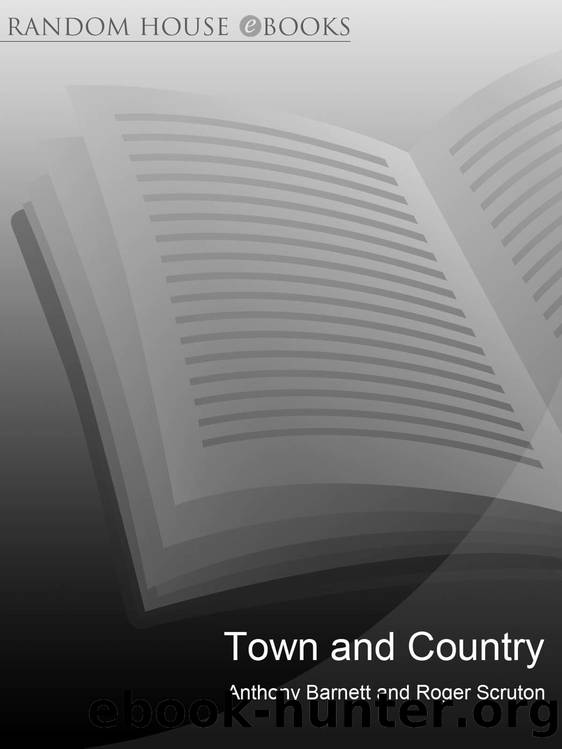Town And Country by Anthony Barnett & Roger Scruton

Author:Anthony Barnett & Roger Scruton [Barnett, Anthony]
Language: eng
Format: epub
Publisher: Random House
Published: 2012-06-30T03:00:00+00:00
17. The Unofficial Countryside
Colin Ward
THE AMIABLE NATURALIST Richard Mabey wrote a book in 1973 describing his wanderings and discoveries in The Unofficial Countryside of suburbia, factory sites, reservoirs, docks and railway tracks, canals, churchyards and allotments, parks and rubbish tips. A quarter of a century later, we have learned to take for granted that many species of plant and insect can no longer be found in agricultural counties doused in pesticides and herbicides and denuded of 130,000 miles of hedgerows. In October 1997 the British Trust for Ornithology reported that a greater variety of bird species were recorded in urban than in rural Britain. The notion that the owners and occupiers of agricultural land are the guardians of flora and fauna has been shown to be an illusion.
There has always been another kind of unofficial country, populated by members of the human species, outside the recognised system of land tenure and land use. By this I donât mean outlaws, emerging from their forest hide-outs to rob the rich and feed the poor, but those cotters and squatters who had managed to survive in the margins and interstices of the landlord and tenant system. Surveys of land ownership from Domesday in the eleventh century, through pipe rolls and subsidy rolls for many centuries, down to the tithe maps of the early Victorian period often failed to notice their minute and marginal holdings, simply because most of these surveys were undertaken to register taxable land or produce. The most devastating blow to the unofficial country was enclosure, when those cottagers who could show no title to their land were simply evicted to seek their future in the densely packed slums of industrial Britain.
But in several parts of the country the Industrial Revolution itself began in these uncharted and unregistered settlements of landless peasants scraping a livelihood in the margins of the economy. The places where they sought survival were often in the âwastesâ between parishes where it was possible to keep a few pigs and chickens while picking up an income from quarrying, mineral extraction or smelting, and later in the enormously labour-intensive work of building the canals and, still later, that of constructing and manning the railways in the valleys below.
In our attempts to read the unofficial landscape, whether on the ground or on the map, we use an old and useful classification of parishes, that of âopenâ and âcloseâ villages. There is, in practice, a continuum between the two, but we associate the âcloseâ village with a single landowner who, through his agents, stewards, bailiffs or tenants, and his links with or patronage of other institutions like law enforcement and the Church, had effective control of everything that happens.
The âopenâ village, on the other hand, is a struggling, unpredictable parish with evidence of owner-built and improvised housing, of mixed occupations and the growth of industry, of religious nonconformity and political radicalism, all of them associated with the dispersal of land ownership. The authors of The Penguin Guide to the Landscape
Download
This site does not store any files on its server. We only index and link to content provided by other sites. Please contact the content providers to delete copyright contents if any and email us, we'll remove relevant links or contents immediately.
The Secret History by Donna Tartt(18859)
The Social Justice Warrior Handbook by Lisa De Pasquale(12143)
Thirteen Reasons Why by Jay Asher(8800)
This Is How You Lose Her by Junot Diaz(6802)
Weapons of Math Destruction by Cathy O'Neil(6152)
Zero to One by Peter Thiel(5692)
Beartown by Fredrik Backman(5609)
The Myth of the Strong Leader by Archie Brown(5429)
The Fire Next Time by James Baldwin(5252)
How Democracies Die by Steven Levitsky & Daniel Ziblatt(5133)
Promise Me, Dad by Joe Biden(5088)
Stone's Rules by Roger Stone(5027)
A Higher Loyalty: Truth, Lies, and Leadership by James Comey(4851)
100 Deadly Skills by Clint Emerson(4845)
Rise and Kill First by Ronen Bergman(4705)
Secrecy World by Jake Bernstein(4652)
The David Icke Guide to the Global Conspiracy (and how to end it) by David Icke(4629)
The Farm by Tom Rob Smith(4442)
The Doomsday Machine by Daniel Ellsberg(4420)
